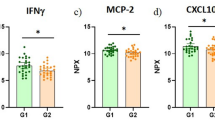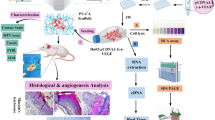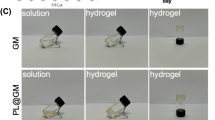Abstract
Objectives:
Many complex mechanisms responsible for the pathogenesis of pressure ulcers (PUs) currently remain poorly understood. The objective of this study was to discover the major roles for inflammatory cytokines, growth factors and several apoptosis-related signal molecules in chronic PU wound.
Methods:
We investigated expression of inflammatory cytokines, growth factors and their corresponding receptors, and the apoptosis signal of caspase-3 in chronic stage III/IV chronic PU wound, acute wounds as well as normal skin controls. Tissues were stained by hematoxylin and eosin (HE) for histopathology and Masson’s trichrome for collagen. Vascular endothelial growth factor (VEGF), fibroblast growth factors 2 (bFGF) and caspase-3 were detected by immunohistochemical analysis. Expression of mRNAs for interleukin (IL)-1β, tumor necrosis factor-α (TNF-α), VEGF, KDR, bFGF and FGFR1 was determined by real-time reverse transcription PCR.
Results:
Stage III and IV chronic PUs stained had increased inflammatory cell infiltration and decreased collagen compared with controls. Levels of mRNAs for inflammatory cytokines IL-1β and TNF-α were elevated in PUs compared with acute wounds and normal skin. VEGF and bFGF, together with their receptors KDR and FGFR1, respectively, were significantly decreased compared with controls. However, the expression levels of caspase-3 were elevated in the PUs.
Conclusion:
Our series of studies have shown that chronic PUs displayed high levels of inflammation and disruption of the collagen matrix, along with increased indications of apoptosis and decreased levels of growth factors and their receptors. These characteristics can be used to comprehensively evaluate the etiology and treatment of chronic PUs.
Similar content being viewed by others
Log in or create a free account to read this content
Gain free access to this article, as well as selected content from this journal and more on nature.com
or
References
Brem H, Tomic-Canic M . Cellular and molecular basis of wound healing in diabetes. J Clin Invest 2007; 117: 1219–1222.
Bishop JB, Phillips LG, Mustoe TA, VanderZee AJ, Wiersema L, Roach DE et al. A prospective randomized evaluator-blinded trial of two potential wound healing agents for the treatment of venous stasis ulcers. J Vasc Surg 1992; 16: 251–257.
Schultz GS, Wysocki A . Interactions between extracellular matrix and growth factors in wound healing. Wound Repair Regen 2009; 17: 153–162.
Xiaobing FU . Pay great attention to the study the pathogenesis and preventive treatment of chronic impaired healing wound on body surface. Chin J Traumatol 2004; 20: 449–451.
Banerjee M, Saxena M . Interleukin-1 (IL-1) family of cytokines: role in Type 2 Diabetes. Clin Chim Acta 2012; 413: 1163–1170.
Ziv I, Zilkha-Falb R, Offen D, Shirvan A, Barzilai A, Melamed E . Levodopa induces apoptosis in cultured neuronal cells-a possible accelerator of nigrostriatal degeneration in Parkinson's disease? Mov Disord 1997; 12: 17–23.
Black J, Baharestani MM, Cuddigan J, Dorner B, Edsberg L, Langemo D et al. National Pressure Ulcer Advisory Panel. National Pressure Ulcer Advisory Panel's updated pressure ulcer staging system. Adv Skin Wound Care 2007; 20: 269–274.
Rapala K, Laato M, Niinikoski J, Kujari H, Söder O, Mauviel A et al. Tumor necrosis factor alpha inhibits wound healing in the rat. Eur Surg Res 1991; 23: 261–268.
Diegelmann RF . Excessive neutrophils characterize chronic pressure ulcers. Wound Repair Regen. 2003; 11: 490–495.
Brown DL, Kao WW, Greenhalgh DG . Apoptosis down-regulates inflammation under the advancing epithelial wound edge: delayed patterns in diabetes and improvement with topical growth factors. Surgery 1997; 121: 372–380.
Desmoulière A, Redard M, Darby I, Gabbiani G . Apoptosis mediates the decrease in cellularity during the transition between granulation tissue and scar. Am J Pathol 1995; 146: 56–66.
Seth AK, Geringer MR, Hong SJ, Leung KP, Galiano RD, Mustoe TA . Comparative analysis of single-species and polybacterial wound biofilms using a quantitative, in vivo, rabbit ear model. PloS ONE 2012; 7: e42897.
Nagata M, Takenaka H, Shibagaki R, Kishimoto S . Apoptosis and p53 protein expression increase in the process of burn wound healing in guinea-pig skin. Br J Dermatol 1999; 140: 829–838.
Carmeliet P, Jain RK . Molecular mechanisms and clinical applications of angiogenesis. Nature 2011; 473: 298–307.
Chiu LL, Radisic M . Scaffolds with covalently immobilized VEGF and Angiopoietin-1 for vascularization of engineered tissues. Biomaterials 2010; 31: 226–241.
Pufe T, Paulsen F, Petersen W, Mentlein R, Tsokos M . The angiogenic peptide vascular endothelial growth factor (VEGF) is expressed in chronic sacral pressure ulcers. J Pathol 2003; 200: 130–136.
Menke J, Iwata Y, Rabacal WA, Basu R, Yeung YG, Humphreys BD et al. CSF-1 signals directly to renal tubular epithelial cells to mediate repair in mice. J Clin Invest 2009; 119: 2330–2342.
Sasaki T . The effects of basic fibroblast growth factor and doxorubicin on cultured human skin fibroblasts: relevance to wound healing. J Dermatol 1992; 19: 664–666.
Rao X, Zhong J, Zhang S, Zhang Y, Yu Q, Yang P et al. Loss of methyl-cpg-binding domain protein 2 enhances endothelial angiogenesis and protects mice against hind-limb ischemic injuryclinical perspective. Circulation 2011; 123: 2964–2974.
Park CJ, Clark SG, Lichtensteiger CA, Jamison RD, Johnson AJ . Accelerated wound closure of pressure ulcers in aged mice by chitosan scaffolds with and without bFGF. Acta Biomater 2009; 5: 1926–1936.
Acknowledgements
This work was supported by the National Natural Science Funding of China (81372064), Science and Technical Department of Zhejiang Province, China (2008C33044) and supported in part by the National Major Basic Research Project (973 program, 2012CB518105).
Author information
Authors and Affiliations
Corresponding author
Ethics declarations
Competing interests
The authors declare no conflict of interest.
Rights and permissions
About this article
Cite this article
Jiang, L., Dai, Y., Cui, F. et al. Expression of cytokines, growth factors and apoptosis-related signal molecules in chronic pressure ulcer wounds healing. Spinal Cord 52, 145–151 (2014). https://doi.org/10.1038/sc.2013.132
Received:
Revised:
Accepted:
Published:
Issue date:
DOI: https://doi.org/10.1038/sc.2013.132
Keywords
This article is cited by
-
Photobiomodulation by dual-wavelength low-power laser effects on infected pressure ulcers
Lasers in Medical Science (2020)
-
Elevated Risk of Infections after Spinal Cord Surgery in Relation to Preoperative Pressure Ulcers: a Follow-up Study
Scientific Reports (2018)
-
Regulation of Langerhans cell functions in a hypoxic environment
Journal of Molecular Medicine (2016)
-
Immune dysfunction and chronic inflammation following spinal cord injury
Spinal Cord (2015)



